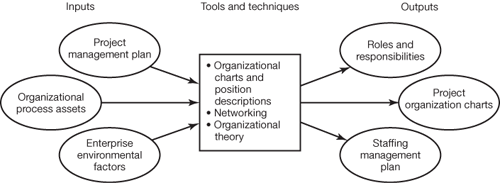HR planning
|
|
Human resource planning occurs during the planning phase of the project lifecycle. It is during this process that the project manager identifies the HR requirements for the project. These requirements will include the roles and responsibilities, reporting relationships and a staffing management plan. Figure 9.2 shows the planning process group to have three inputs, three tools and techniques and three outputs. The three inputs to this process group should by now be familiar to you: enterprise environmental factors, organizational process assets, and the project management plan. However, as with all the knowledge areas, different aspects of each input are brought into play for different knowledge areas.
Figure 9.2. The HR planning processAdapted from PMBOK Guide (p.203)
As we have seen before, enterprise environmental factors are any external environment or internal organizational factors that may affect the delivery of the project. In many processes they are 'nice to have' rather than absolutely necessary inputs to the process. However, in the HR processes, and especially in HR planning, it is vital to consider this input, especially legal and regulatory requirements and any that affect morale. The same goes for organizational process assets and HR management processes. Templates and checklists are particularly useful in HR planning. They can be used to help identify core competency requirements of team members or could show the organizational chart. There are three tools and techniques applicable in the HR planning process:
There are many ways to depict the structure of an organization using organizational charts and position descriptions. There are three main types of organizational charts. Figure 9.3 shows an example of the hierarchical-type charts that are considered to be traditional organizational charts. This has the head of the organization, function, department or group at the top, and their direct reports feeding into them in a top-down diagram.
Figure 9.3. Hierarchical organizational chartFigure 9.4 illustrates matrix-based charts, which are best exemplified by the responsibilities matrix. A responsibility matrix lays out the major activities in the project and specifies the responsibilities of each stakeholder involved in a project. It is an important project communication tool because all stakeholders can see clearly who to contact for each activity. Text-oriented formats can be used to provide detailed written descriptions of a team member's roles and responsibilities. Some roles and responsibilities are outlined in other sections of the project management plan. For example, the risk and issue logs will identify the risk and issue owners.
Figure 9.4. A matrix-based responsibility chart
The second tool or technique is networking. Networking can be done within an organization or external to it, such as at conferences or trade fairs. Networking is generally considered to be an informal affair, and can include lunches, correspondence and conversation. The third and final tool is organizational theory. This is able to provide 'information regarding the ways that people, teams, and organizational units behave. Applying proven principles shortens the amount of time needed to create the human resource planning outputs and improves the likelihood that the planning will be effective' (PMBOK). What does this mean in real life? Very simply, if you are experiencing organizational projects in your team, go and read up on the latest theories: do a Google search of a reputable organizational behaviour site, buy a book on organizational behaviour, or talk to an organizational psychologist. Your aim should not be to become an expert that is not your job but to use any existing tools or techniques to solve the problem in your team. The roles and responsibilities developed during human resource planning should describe the role, the authority level of the person, their responsibilities and the competency required to complete the project activities. The project organizational chart will represent graphically the project team members and their reporting lines. The final output, the staffing management plan, forms part of the project management plan. It is usual for the staffing management plan to include the following:
|
|
Top of Page



